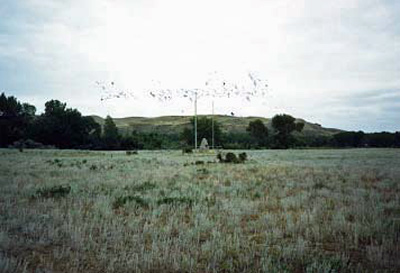Fort Whoop-Up National Historic Site of Canada
Lethbridge, Alberta

View of a cairn placed at Fort Whoop-Up
(© Trudy Cowan, Parks Canada | Parcs Canada, 1989.)
Address :
Junction of the St. Mary and Oldman rivers, Lethbridge, Alberta
Recognition Statute:
Historic Sites and Monuments Act (R.S.C., 1985, c. H-4)
Designation Date:
1963-10-28
Dates:
-
1869 to 1869
(Construction)
-
1869 to 1874
(Significant)
-
1876 to 1897
(Significant)
Event, Person, Organization:
-
North West Mounted Police (NWMP)
(Organization)
-
Albert B. Hamilton
(Builder)
-
John J. Healy
(Builder)
Other Name(s):
-
Fort Whoop-Up
(Designation Name)
-
Fort Hamilton
(Other Name)
Research Report Number:
1962-022, 1989-OB-08, 2009-SDC-CED-059
DFRP Number:
14993 00
Plaque(s)
Existing plaque: Located next to the Fort Whoop-Up visitor centre 200 Indian Battle Road South, Lethbridge, Alberta
Established in 1869 as a base for trade with the Indians, Fort Whoop-Up was the earliest and most notorious of the "whisky forts" built by Americans on Canadian soil. During the years 1869-74 traders dealing in contraband liquor and firearms so demoralized the Indians that violence and disorder resulted. Lawless conditions here and in other areas hastened the formation of the North West Mounted Police in 1873 to assure the maintenance of law and order in western Canada.
*Note: This designation has been identified for review. A review can be triggered for one of the following reasons - outdated language or terminology, absence of a significant layer of history, factual errors, controversial beliefs and behaviour, or significant new knowledge.
Description of Historic Place
Fort Whoop-Up National Historic Site of Canada is located on a grassy river valley terrace, near the confluence of the St. Mary and Oldman rivers, just south of Lethbridge, Alberta. While there are no remaining aboveground traces of the fort itself, a stone-lined well is visible and low depressions in the ground indicate the original location of the fort’s cellar pits. Official recognition refers to the area marked on a survey of the area dated 10 August 1985.
Heritage Value
Fort Whoop-Up was designated a national historic site of Canada in 1963. It is designated because: lawless conditions at Fort Whoop-Up, the earliest and most notorious of the “whisky forts,” hastened the formation of the North-West Mounted Police in 1873 to assure the maintenance of law and order in western Canada.
As a result of an 1832 United States law prohibiting the sale of whiskey to Native Americans, two Montana traders, Albert B. Hamilton and John J. Healy, traveled to Canada and established Fort Hamilton in 1869. This “Whisky Fort” became a trading business that competed with the local Hudson’s Bay Company (HBC). Although the HBC sold many of the same goods as Hamilton and Healy, including firearms, foodstuffs and textiles, among other trade items, the HBC sold rum in place of whiskey. The sale of whiskey and firearms from Fort Hamilton led to disorder among the First Nations in the area, and the fort was renamed Fort Whoop-Up in recognition of its reputation as one of the more dangerous and lawless forts in the northwest. The attempt to establish law and order within the region was one of the factors leading to the formation of the North West Mounted Police (NWMP) in 1873.
In 1870, the original fort was destroyed in a fire. A second larger fort, located further north of the original site replaced it. This larger fort contained dwellings, a kitchen, a trade room, a blacksmith’s forge, and an infamous saloon that was the scene of several dangerous incidents. Despite the violence, Fort Whoop-Up was an essential link in the transportation of pelts and hides, and remained the headquarters of trade between Canada and Montana until 1874 when the American traders abandoned the fort. Following the departure of the Americans, the NWMP used the site as an outpost of their Lethbridge detachment periodically between 1876 and 1897. Eventually falling into disrepair, the fort was badly damaged by fire in 1888, and was subsequently dismantled by local settlers for scrap metal and lumber.
Character-Defining Elements
Key elements contributing to the heritage value of this site include: - its location south of Lethbridge, overlooking the confluence of the St. Mary and Oldman rivers; - its setting on a grassy river valley terrace, which features a Lethbridge Chamber of Commerce memorial cairn and a Historic Sites and Monuments Board of Canada memorial; the remains of the two phases of the fort, in their location, extent and materials, both discovered and undiscovered; - the integrity of the stone-lined well opening, in its location, extent and materials; - the integrity of the low cellar depression in the ground surface in its footprint and location; - viewscapes of the site and the surrounding hilly grassed landscape.